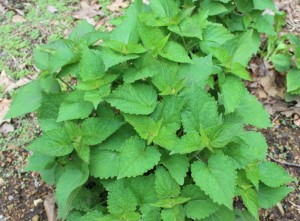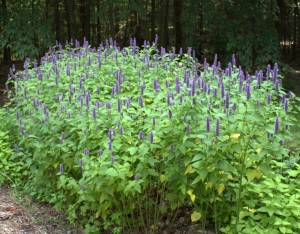Anise hyssop is a perennial herb, Agastache foeniculum, that is a member of the mint family, Lamiaceae. It’s native to North America and grows wild in the grasslands of the Midwest. It’s also called blue giant hyssop because of the pretty blue flowers and its tall growth habit.

The root system survives from year to year and the above ground parts of the plant will die back during winter to be replaced by new growth the following spring.
Typical of many mints the scallop-edged, triangular leaves lie opposite one another and the stems are square in cross-section. When bruised the leaves emit the scent of anise or fennel, so it’s also known as anise-mint, licorice-mint or fennel hyssop. In a well-fertilized garden anise hyssop can grow to four or five feet tall, but it generally is about three feet tall in nature. It will readily accept pruning, becoming bushier when clipped as new growth arises from the leaf axils. Pruning anise hyssop during the growing season will produce two or three harvests. Alternatively, leaves can be harvested as needed.

Irregular flowers cluster at the stem tips in interrupted spikes, and they occur in the leaf axils. The blueish-purple blooms are tubular in shape with four long stamens that protrude. The blossoms are open from mid-summer to fall with the spikes elongating throughout the blooming period. In the garden these stunning spikes of flowers really draw one’s attention. The beautiful flowers also attract butterflies.
Anise hyssop makes a delightful addition to mixed herbal teas and a fine tea all to itself. The leaves are dried for the cold weather months or used fresh during the summertime. A tablespoon of bruised leaves is steeped in near boiling water for ten minutes. The tea is naturally sweet, so extra sweetener is not necessary. In fact the tea is so sweet that it can be used to sweeten other foods. Poach peaches in the tea for an interesting twist.
Leaves can be finely chopped and added to green salads, fruit salad, mayonnaise-based salads, bean dishes and potatoes. Anywhere a taste of licorice or anise would enhance a dish, try anise hyssop leaves instead of anise seeds. Press leaves into a pie crust before baking for a pleasant surprise.
Folklore medicine employed anise hyssop herbal tea to treat colds, coughs and fevers, to induce sweating, and to strengthen a weak heart. Modern science hasn’t substantiated any of of these claims, but it may be effective in reducing congestion when used in a steam bath.
Is there another plant that looks very similar that smells sort of skunky?
Hey Pat!
I think you’re talking about catnip. It can be sort of skunky and has a rather strong smell. Check it out: http://usethatherb.com/catnip-kittys-garden-plant-herbal-tea/
Does that look about right?
Should the leaves be harvested before the flowers appear?
Do the smaller/newest leaves give better flavor?
Can the flowers be used too, to enhance the tea?
What method do you recommend to wash the leaves?
Do you air dry or microwave the clean leaves to preserve them for winter?
Thank you!
Hi Caroll,
Flowers can be included with your tea leaves. We harvest before and after flowering, as needed. We just harvest some as we go along so I’m not really sure about using smaller leaves versus the older ones. Leaf washing escapes us too. In general we pick through the leaves and only dry the ones that look pristine without holes or chew marks or dirt. Lower leaves might get a little ragged or have dirt splashed on them so they get left behind in the compost.
Air drying for sure. Sometimes, instead of plucking leaves, a whole plant will be uprooted and dried. That’s due to our haphazard way of letting volunteers grow where they spring up, most of the time. If a hyssop plant is in a spot where a cucumber needs to go, up comes the anise and in goes the cuke.
I’m afraid that the microwave would draw out some/too much of the anise essence so we haven’t tried that. Do let us know if you think it’s a time saver!
In any case let us know how you like the tea and if you mix it with any other herb or sweeteners.
Hello, can I use your picture of hyssop in my self published book, if I reference your page?
That’s cool, David. Care to send me an advanced copy for review?
Look forward to it!